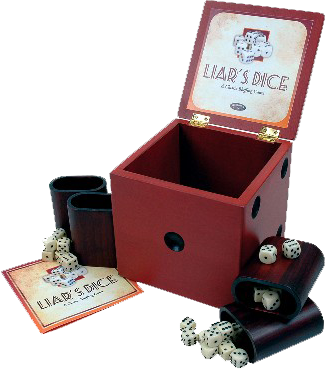Liar's Dice
The Liar's dice is a variety of dice games that can be played by 2 or more players. These games are
also known as Liar dice. The games are fairly easy to learn, requiring very little equipments, and can
be easily played as drinking or gambling games. The ability to trick the opponents as well as to detect
any attempt of deception by the opponent players are the main prerequisites that are needed to
play this game well.
The game of Liar's Dice was originated in South America. It was then popularized by the Spaniards.
The renowned Spanish conqueror by the name of Francisco Pizarro brought the game to Spain in the
16th century. The game later achieved greatly popularity with the masses in Hong Kong as well as
in mainland China. Many Chinese bars and clubs arrange for dice and cups for their visitors to play a
friendly game of Liar's Dice.
Strategy in Liar's Dice
A game of Liar's Dice involves various intricate subtleties and requires many interpersonal skills that
are similar to numerous bluffing games like Poker. Even though individual varieties of Liar's Dice
games vary in their strategy, there are some common forms of strategic moves that are universal for
all forms of Liar's Dice games.
 Perhaps the most important thing to keep in mind is that a bid played by one player provides
valuable information about that player to the other players at the table. The players reveal their
confidence on each of the face values rolled through subsequent bids. A player with 2 or 3 of a given
face value under her or his cup can make a bid that favors that face value. The players can use the
bids to form an idea about the unknown values. This affects their level of confidence in a particular
bid that they were considering. In some other instances, a player may consider a certain bid as
an evidence of it being true. If the player's own dice status supports the same conclusion, it can
increase the bid in that face value. Again, if the dice does not support the conclusion, it may choose
to bid on another face value or try to challenge the earlier bid.
Perhaps the most important thing to keep in mind is that a bid played by one player provides
valuable information about that player to the other players at the table. The players reveal their
confidence on each of the face values rolled through subsequent bids. A player with 2 or 3 of a given
face value under her or his cup can make a bid that favors that face value. The players can use the
bids to form an idea about the unknown values. This affects their level of confidence in a particular
bid that they were considering. In some other instances, a player may consider a certain bid as
an evidence of it being true. If the player's own dice status supports the same conclusion, it can
increase the bid in that face value. Again, if the dice does not support the conclusion, it may choose
to bid on another face value or try to challenge the earlier bid.
A bid can also be a bluff. The bluffs in a game of Liar's Dice are commonly split into 2 main
categories; the early bluffs and the late bluffs. Early bluffs are most likely to be corrected by some
simple probability, which depends on the total number of players. However, the other players are
prone to believe that the bidder settled for that bid because her or his dice supported it. Hence,
the bluff generates false information which can make the players bid wrongly on that particular
face value. The players will thus try to trick the opponents into overbidding by making early bluffs
in order to inflate a definite face value. Late bluffs are generally less voluntary. Often a player is
not willing to contradict a bid. However, as one higher bid has more probability to be incorrect, the
proposition seems to be even less appealing. Late bluffs are often an essential part of a Liar's Dice
game.